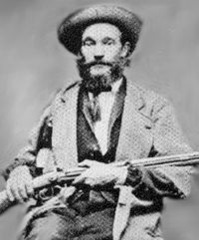Nessmuk—it rhymes with e-book
By Joseph Gray
 Nessmuk was the pen name of George W. Sears, who wrote extensively for Forest and Stream magazine in the late 1800’s. The name is supposed to mean “wood duck” in the language of a Massachusetts Indian tribe. Sears also wrote two books, Woodcraft and Forest Runes, which is a volume of poetry.
Nessmuk was the pen name of George W. Sears, who wrote extensively for Forest and Stream magazine in the late 1800’s. The name is supposed to mean “wood duck” in the language of a Massachusetts Indian tribe. Sears also wrote two books, Woodcraft and Forest Runes, which is a volume of poetry.
The book Woodcraft was originally published in 1884 by Forest and Stream Publishing. The book was immensely popular and remained in print for decades. The last edition was published in 1920, again by Forest and Stream. In 1963, Dover Publishing did a somewhat edited reprint of the 1920 edition, calling it Woodcraft and Camping.
What was unique about this book was the philosophy of the author, which is illustrated by this passage: “Go light; the lighter the better, so that you have the simplest material for health, comfort and enjoyment.” This was written well over 100 years ago, when most people who took to the woods needed guides and horses to carry all of their excess equipment. If you do an internet search on “Nessmuk”, you will see that even today, there are those who can sell you an ultra-light “Nessmuk canoe”.
Sears was not among the rich or the elite, which comprised the bulk of outdoor enthusiasts in his day. He thought that the outdoors should be for the everyday man… “there are hundreds of thousands of practical, useful men, many of them far from being rich; mechanics, artists, writers, merchants, clerks, business men—workers, so to speak—who sorely need and well deserve a season of rest and relaxation at least once a year. To these and for these, I write.”
What this has to do with e-books
Just what does any of this have to do with e-books, you ask? Glad you asked. I came across a PDF copy of the 1920 edition of Woodcraft on the internet. I found it an interesting read, but the PDF was littered with OCR errors and missing passages. Being interested in e-books, I decided to create a better version of this classic.
Although it wasn't perfect, I started with the PDF copy that I had, so that I didn’t have to re-scan the entire book. I extracted the raw text from the PDF, and with the help of some inter-library loans, I corrected the text and added missing passages. I did scan the illustrations from the physical book, as the images in the PDF were rather poor.
My initial goal was to create an online version of the e-book. Along the way, I added a glossary, and pop-ups that show you a definition for some uncommon words. I am rather pleased with the result, which you can find linked on my web page. If you spot an error, I would appreciate hearing about it, so that I can make corrections. A note about the popups: they work in Firefox and Internet Explorer, but not in Opera for some reason. I tried a few fixes, but they still don’t work in Opera.
Easy to create epub
As I used XHTML and CSS for the web version, it was very easy to create an epub ebook. Sadly, I had to remove the word popups, as the CSS needed to do this is not supported by the epub specification. I may try another way to do this within an epub, thanks to a tip from Jon Noring, here in the TeleBlog. You can download the epub version of Woodcraft from my web page. I may add other e-book formats for download later.
I tested the epub version in Digital Editions, as it currently offers the most complete support for epub. The e-book displayed just fine, for the most part. I did have two problems however: the drop-caps do not display correctly; if you click on one of the words that are linked to the glossary, there is no “back” button to return to where you were reading. Otherwise, Digital Editions did a good job with this e-book. You can also read this epub in FBReader with satisfactory results.
Finding a gem such as Woodcraft proves once again that there is a treasure trove of public domain works out there that are locked up in dusty volumes, and not easily available to the general public. And don’t even think about trying to buy an old copy of this book. Most booksellers consider it a “rare” book and want quite a price for it. Hopefully, this small effort of mine will help to bring another classic book to the attention of those who might otherwise never know of it. As a future project, I may try converting Nessmuk’s book of poetry, Forest Runes to electronic format.
Moderator’s note: I changed the time stamp of this post to move it closer to the top of Monday’s TeleBlog. - DR
